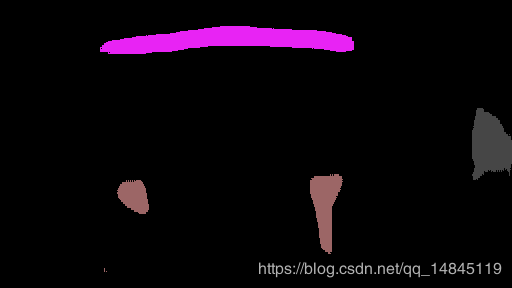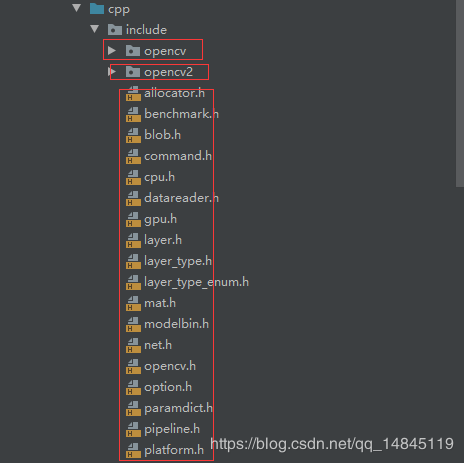您好,登錄后才能下訂單哦!
您好,登錄后才能下訂單哦!
小編給大家分享一下如何基于Android studio3.6的JNI教程之ncnn之語義分割ENet,相信大部分人都還不怎么了解,因此分享這篇文章給大家參考一下,希望大家閱讀完這篇文章后大有收獲,下面讓我們一起去了解一下吧!
Android是一種基于Linux內核的自由及開放源代碼的操作系統,主要使用于移動設備,如智能手機和平板電腦,由美國Google公司和開放手機聯盟領導及開發。
本代碼可以在模擬器下進行跑。
環境:
Android studio 3.6
Sdk:android10 api 29
Ndk:r15c
Ncnn:20200226
Opencv:Opencv3.4.1 android sdk
Linux下的代碼測試:
mkdir build
cd build
cmake ..
make
./enet
運行效果,

Android開始:
(1)新建工程,
New->New Project->選擇Native c++ ->工程名enet->c++11
(2)app/src/cpp下面增加opencv和ncnn的頭文件,include

(3)app/src/main下面增加ncnn 和opencv的靜態庫文件和動態庫文件,

(4)app/src/main下面增加模型文件assets

(5)修改布局文件,app/src/main/res/layout/ activity_main.xml
<?xml version="1.0" encoding="utf-8"?> <RelativeLayout xmlns:android="http://schemas.android.com/apk/res/android" xmlns:app="http://schemas.android.com/apk/res-auto" xmlns:tools="http://schemas.android.com/tools" android:layout_width="match_parent" android:layout_height="match_parent" tools:context=".MainActivity"> <LinearLayout android:id="@+id/btn_ll" android:layout_alignParentBottom="true" android:layout_width="match_parent" android:layout_height="wrap_content" android:orientation="horizontal"> <Button android:id="@+id/use_photo" android:layout_weight="1" android:layout_width="0dp" android:layout_height="wrap_content" android:text="選圖"/> <Button android:id="@+id/detect_photo" android:layout_weight="1" android:layout_width="0dp" android:layout_height="wrap_content" android:text="分割"/> </LinearLayout> <ImageView android:id="@+id/show_image" android:layout_width="match_parent" android:layout_height="match_parent" android:layout_above="@id/btn_ll" android:layout_alignParentTop="true" android:layout_marginTop="1dp" android:layout_marginBottom="-1dp" /> </RelativeLayout>
(6) app/src/main/java/com/example/enet增加ENET類,
public class ENET {
public native boolean Init(byte[] param, byte[] bin);
public native float[] Process(Bitmap bitmap);
// Used to load the 'native-lib' library on application startup.
static {
System.loadLibrary("ENET");
}
}(7) app/src/main/cpp/enet-jni.cpp實現其jni方法,
extern "C"
JNIEXPORT jboolean JNICALL
Java_com_example_enet_ENET_Init(JNIEnv *env, jobject thiz, jbyteArray param, jbyteArray bin) {
// TODO: implement Init()
ncnn::Mat ncnn_param;
ncnn::Mat ncnn_bin;
// init param
{
int len = env->GetArrayLength(param);
ncnn_param.create(len, (size_t) 1u);
env->GetByteArrayRegion(param, 0, len, (jbyte *) ncnn_param);
}
// init bin
{
int len = env->GetArrayLength(bin);
ncnn_bin.create(len, (size_t) 1u);
env->GetByteArrayRegion(bin, 0, len, (jbyte *) ncnn_bin);
}
ncnn_net = new ENET(ncnn_param,ncnn_bin);
return JNI_TRUE;
}
extern "C"
JNIEXPORT jfloatArray JNICALL
Java_com_example_enet_ENET_Process(JNIEnv *env, jobject thiz, jobject bitmap) {
// TODO: implement Process()
// ncnn from bitmap
ncnn::Mat in;
{
AndroidBitmapInfo info;
AndroidBitmap_getInfo(env, bitmap, &info);
int width = info.width;
int height = info.height;
if (info.format != ANDROID_BITMAP_FORMAT_RGBA_8888)
return NULL;
void* indata;
AndroidBitmap_lockPixels(env, bitmap, &indata);
// 把像素轉換成data,并指定通道順序
// 因為圖像預處理每個網絡層輸入的數據格式不一樣一般為300*300 128*128等等所以這類需要一個resize的操作可以在cpp中寫,也可以是java讀入圖片時有個resize操作
//in = ncnn::Mat::from_pixels_resize((const unsigned char*)indata, ncnn::Mat::PIXEL_RGBA2RGB, width, height,300,300);
in = ncnn::Mat::from_pixels(static_cast<const unsigned char *>(indata), ncnn::Mat::PIXEL_RGBA2BGR, width, height);
// 下面一行為debug代碼
__android_log_print(ANDROID_LOG_DEBUG, "ENetJniIn", "enet_process_has_input1, in.w: %d; in.h: %d in.c:%d ", in.w, in.h,in.c);
//AndroidBitmap_unlockPixels(env, bitmap);
}
{
ncnn::Mat out = ncnn_net->process(in);
__android_log_print(ANDROID_LOG_DEBUG, "ENetJniIn", "enet_process_has_output, in.w: %d; in.h: %d in.c:%d ", out.w, out.h,out.c);
int output_wsize = out.w;
int output_hsize = out.h;
//輸出整理
float *output[output_wsize * output_hsize]; // float類型
for(int i = 0; i< out.h; i++) {
for (int j = 0; j < out.w; j++) {
output[i*output_wsize + j] = &out.row(
i)[j];
}
}
//建立float數組 長度為 output_wsize * output_hsize,如果只是ouput_size相當于只有一行的out的數據那就是一個object檢測數據
jfloatArray jOutputData = env->NewFloatArray(output_wsize * output_hsize);
if (jOutputData == nullptr) return nullptr;
env->SetFloatArrayRegion(jOutputData, 0, output_wsize * output_hsize,
reinterpret_cast<const jfloat *>(*output));
return jOutputData;
}
}(8) app/src/main/java/com/example/enet中MainActivity做具體的調用實現,
public class MainActivity extends AppCompatActivity {
private ENET enet = new ENET(); //java接口實例化 下面直接利用java函數調用NDK c++函數
private Bitmap yourSelectedImage = null;
private static final int SELECT_IMAGE = 1;
private static final String TAG = MainActivity.class.getName();
private ImageView show_image;
private boolean load_result = false;
private int[] ddims = {1, 3, 512, 288}; //這里的維度的值要和train model的input 一一對應
@Override
protected void onCreate(Bundle savedInstanceState) {
super.onCreate(savedInstanceState);
setContentView(R.layout.activity_main);
try
{
initENet();//初始化模型
Log.e("MainActivity", "initENet ok");
} catch (IOException e) {
Log.e("MainActivity", "initENet error");
}
init_view();//檢測+view畫圖
}
// initialize view
private void init_view() {
show_image = (ImageView) findViewById(R.id.show_image);
Button use_photo = (Button) findViewById(R.id.use_photo);
use_photo.setOnClickListener(new View.OnClickListener() {
@Override
public void onClick(View arg0) {
Intent i = new Intent(Intent.ACTION_PICK);
i.setType("image/*");
startActivityForResult(i, SELECT_IMAGE);
}
});
Button detect_photo = (Button) findViewById(R.id.detect_photo);
detect_photo.setOnClickListener(new View.OnClickListener() {
@Override
public void onClick(View arg0) {
if (yourSelectedImage == null)
return;
predict_image(yourSelectedImage);
}
});
}
private void initENet() throws IOException {
byte[] param = null;
byte[] bin = null;
{
//用io流讀取二進制文件,最后存入到byte[]數組中
InputStream assetsInputStream = getAssets().open("enet_512288.param.bin");// param: 網絡結構文件
int available = assetsInputStream.available();
param = new byte[available];
int byteCode = assetsInputStream.read(param);
assetsInputStream.close();
}
{
//用io流讀取二進制文件,最后存入到byte上,轉換為int型
InputStream assetsInputStream = getAssets().open("enet_512288.bin");//bin: model文件
int available = assetsInputStream.available();
bin = new byte[available];
int byteCode = assetsInputStream.read(bin);
assetsInputStream.close();
}
load_result = enet.Init(param, bin);// 再將文件傳入java的NDK接口(c++ 代碼中的init接口 )
Log.d("load model", "ENet_load_model_result:" + load_result);
}
@Override
protected void onActivityResult(int requestCode, int resultCode, Intent data)
{
super.onActivityResult(requestCode, resultCode, data);
if (resultCode == RESULT_OK && null != data) {
Uri selectedImage = data.getData();
try
{
if (requestCode == SELECT_IMAGE) {
Bitmap bitmap = decodeUri(selectedImage);
Bitmap rgba = bitmap.copy(Bitmap.Config.ARGB_8888, true);
// resize to 512x288
yourSelectedImage = Bitmap.createScaledBitmap(rgba, ddims[2], ddims[3], false);
show_image.setImageBitmap(yourSelectedImage);
}
}
catch (FileNotFoundException e)
{
Log.e("MainActivity", "FileNotFoundException");
return;
}
}
}
private Bitmap decodeUri(Uri selectedImage) throws FileNotFoundException
{
// Decode image size
BitmapFactory.Options o = new BitmapFactory.Options();
o.inJustDecodeBounds = true;
BitmapFactory.decodeStream(getContentResolver().openInputStream(selectedImage), null, o);
// The new size we want to scale to
final int REQUIRED_SIZE = 600;
// Find the correct scale value. It should be the power of 2.
int width_tmp = o.outWidth, height_tmp = o.outHeight;
int scale = 1;
while (true) {
if (width_tmp / 2 < REQUIRED_SIZE
|| height_tmp / 2 < REQUIRED_SIZE) {
break;
}
width_tmp /= 2;
height_tmp /= 2;
scale *= 2;
}
// Decode with inSampleSize
BitmapFactory.Options o2 = new BitmapFactory.Options();
o2.inSampleSize = scale;
return BitmapFactory.decodeStream(getContentResolver().openInputStream(selectedImage), null, o2);
}
// predict image
private void predict_image(Bitmap bmp) {
// picture to float array
Bitmap rgba = bmp.copy(Bitmap.Config.ARGB_8888, true);
// resize
Bitmap input_bmp = Bitmap.createScaledBitmap(rgba, ddims[2], ddims[3], false);
try {
// Data format conversion takes too long
// Log.d("inputData", Arrays.toString(inputData));
long start = System.currentTimeMillis();
// get predict result
float[] result = enet.Process(input_bmp);
// time end
long end = System.currentTimeMillis();
Log.d(TAG, "origin predict result:" + Arrays.toString(result));
long time = end - start;
Log.d("result length", "length of result: " + String.valueOf(result.length));
// 畫布配置
Canvas canvas = new Canvas(input_bmp);
//圖像上畫矩形
Paint paint = new Paint();
//continue to draw rect
Log.d(TAG, "result :" + result.length);
Log.d(TAG, "result :" + Arrays.toString(result));
for(int num = 0; num < result.length; num++){
// 畫框
int row =num%ddims[2];
int col = num/ddims[2];
if (result[num]==1){
paint.setColor(Color.RED);
paint.setStyle(Paint.Style.STROKE);//不填充
canvas.drawCircle(row, col, 1, paint);
}
if (result[num]==2){
paint.setColor(Color.BLUE);
paint.setStyle(Paint.Style.STROKE);//不填充
canvas.drawCircle(row, col, 1, paint);
}
if (result[num]==3){
paint.setColor(Color.GREEN);
paint.setStyle(Paint.Style.STROKE);//不填充
canvas.drawCircle(row, col, 1, paint);
}
}
show_image.setImageBitmap(input_bmp);
} catch (Exception e) {
e.printStackTrace();
}
}
}(9) app/src/main/cpp下面修改CMakeLists
cmake_minimum_required(VERSION 3.4.1)
include_directories(include)
file(GLOB ENET_SRC *.h
*.cpp)
set(ENET_COMPILE_CODE ${ENET_SRC})
add_library(libopencv_java3 SHARED IMPORTED)
set_target_properties(libopencv_java3 PROPERTIES IMPORTED_LOCATION
${CMAKE_SOURCE_DIR}/../jniLibs/${ANDROID_ABI}/libopencv_java3.so)
add_library(libncnn STATIC IMPORTED )
set_target_properties(libncnn
PROPERTIES IMPORTED_LOCATION
${CMAKE_SOURCE_DIR}/../jniLibs/${ANDROID_ABI}/libncnn.a)
add_library( # Sets the name of the library.
ENET ## 為生成.so的文字最好直接和.c名字一樣,需要更改
# Sets the library as a shared library.
SHARED
# Provides a relative path to your source file(s).
${ENET_COMPILE_CODE})##cpp文件的name
find_library( # Sets the name of the path variable.
log-lib
# Specifies the name of the NDK library that
# you want CMake to locate.
log )
target_link_libraries( # Specifies the target library.
ENET
libncnn
libopencv_java3
jnigraphics
android
# Links the target library to the log library
# included in the NDK.
${log-lib} )(10) app/src/下面修改build.gradle,增加下面的設置,
externalNativeBuild {
cmake {
arguments "-DANDROID_TOOLCHAIN=clang"
cFlags "-fopenmp -O2 -fvisibility=hidden -fomit-frame-pointer -fstrict-aliasing -ffunction-sections -fdata-sections -ffast-math "
cppFlags "-fopenmp -O2 -fvisibility=hidden -fvisibility-inlines-hidden -fomit-frame-pointer -fstrict-aliasing -ffunction-sections -fdata-sections -ffast-math "
arguments "-DANDROID_STL=c++_shared", "-DANDROID_CPP_FEATURES=rtti exceptions"
cppFlags ""
cppFlags "-std=c++11"
cppFlags "-frtti"
cppFlags "-fexceptions"
}
}
ndk {
abiFilters 'armeabi-v7a'// , 'arm64-v8a' //,'x86', 'x86_64', 'armeabi'
stl "gnustl_static"
}整體目錄結構:

最終效果:

以上是“如何基于Android studio3.6的JNI教程之ncnn之語義分割ENet”這篇文章的所有內容,感謝各位的閱讀!相信大家都有了一定的了解,希望分享的內容對大家有所幫助,如果還想學習更多知識,歡迎關注億速云行業資訊頻道!
免責聲明:本站發布的內容(圖片、視頻和文字)以原創、轉載和分享為主,文章觀點不代表本網站立場,如果涉及侵權請聯系站長郵箱:is@yisu.com進行舉報,并提供相關證據,一經查實,將立刻刪除涉嫌侵權內容。